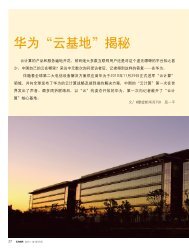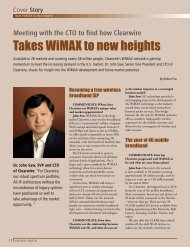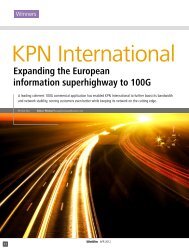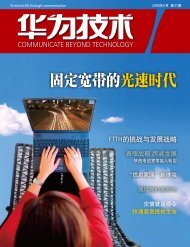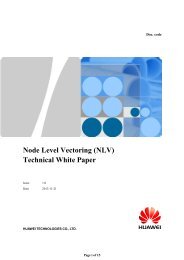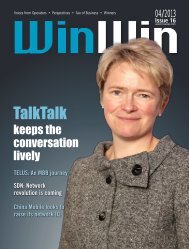EMOBILE: the mobile broadband revolutionist - Huawei
EMOBILE: the mobile broadband revolutionist - Huawei
EMOBILE: the mobile broadband revolutionist - Huawei
Create successful ePaper yourself
Turn your PDF publications into a flip-book with our unique Google optimized e-Paper software.
equire broad geographic coverage. We believe that building<br />
a Tera-Scale bearer network will become a competitive<br />
requirement for leading global operators.<br />
With extremely high extendibility, <strong>Huawei</strong> IPTime<br />
Solution has <strong>the</strong> capability of 80T as Router Cluster System,<br />
which will reach even higher with <strong>the</strong> development of 100G<br />
interface technologies. Its adoption of unified control plane<br />
enables seamless interactions between <strong>the</strong> IP layer and <strong>the</strong><br />
optical layer. Such architecture can offer higher transport<br />
efficiency, increasing return on investment and enhancing<br />
operators’ core competitiveness in <strong>the</strong> era of <strong>broadband</strong>.<br />
New voice business models<br />
Current <strong>mobile</strong> network operators receive 70% of <strong>the</strong>ir<br />
revenue from voice services, a market category that is<br />
being pressured by a continual decrease in ARPU. There is<br />
a natural shift in focus towards <strong>the</strong> more attractive revenue<br />
from data services, but this overlooks a critical element of<br />
user preference. Voice represents <strong>the</strong> most natural, efficient<br />
and convenient way of acquiring information that suits all<br />
scenarios and surroundings. How to capitalize on this and<br />
how to leverage voice as a new channel for communication<br />
and information acquisition, such as with <strong>the</strong> web, has<br />
turned into one of <strong>the</strong> most-debated and most difficult<br />
technical propositions. It is our belief that <strong>the</strong>re is huge<br />
market potential to tap in voice.<br />
New business models are <strong>the</strong> answers to this need. A<br />
good illustration would be <strong>the</strong> “Best Tone” service offered<br />
by China Telecom. An industry-leading innovation and<br />
a fast growing service, Best Tone has become a significant<br />
driver for <strong>the</strong> operator’s voice revenue growth.<br />
Value creation in <strong>broadband</strong><br />
While Moore’s Law will help decrease <strong>the</strong> cost, size and<br />
power of <strong>the</strong> equipment required to handle <strong>the</strong> massive<br />
increases in <strong>broadband</strong> data traffic, it can not keep up<br />
with <strong>the</strong> projected growth. The growth of <strong>the</strong> required<br />
equipment will result in significant increases in both capital<br />
and operational expenses, which can not be recovered<br />
from <strong>the</strong> revenue of passing basic data traffic. To tackle this<br />
challenge, operators will need intelligent traffic management<br />
to enhance bandwidth utilization, coupled with traffic-based<br />
user behavior analysis to generate additional revenue streams<br />
through targeted advertising or o<strong>the</strong>r new models.<br />
Content and media services<br />
To d a y t h e n e t w o r k i s t r a n s i t i o n i n g f r o m a<br />
communications vehicle into an infrastructure that sustains<br />
all elements of society. This will lead to a new trillion-<br />
USD market for businesses who provide <strong>the</strong>ir services<br />
over <strong>the</strong> Internet. As <strong>the</strong> new potential is unfolding,<br />
leading operators are all looking to transforming to add<br />
content and media services, on top of <strong>the</strong>ir traditional<br />
pipe offerings. The content and media arenas require new<br />
capabilities, skills and levels of user interaction that will<br />
challenge traditional operators. The service experience,<br />
development methodology and business model are<br />
dramatically different and community-based interactions<br />
are emerging as <strong>the</strong> fundamental trait of future services.<br />
User-driven and user generated content will be <strong>the</strong><br />
prevailing <strong>the</strong>me and a large number of personalized<br />
offerings will enter <strong>the</strong> market based on <strong>the</strong> long tail<br />
<strong>the</strong>ory. These offerings will be nurtured by <strong>the</strong> changing<br />
character of <strong>the</strong> network, where sharp declines in <strong>the</strong> cost<br />
of services will make it possible for “niche offerings” to<br />
win. Take publishing for example: traditionally <strong>the</strong> cost<br />
of a book could be recovered only if multiple thousands<br />
of copies were sold. With new network capabilities,<br />
<strong>the</strong> digital world increases competition, resulting in<br />
an ecosystem characterized by radical cost reductions,<br />
sometimes to zero, making on-line books profitable even<br />
with a small volume.<br />
Virtual computing<br />
The ability to deliver high-speed data connections<br />
anywhere allows <strong>the</strong> world of computing to shift from<br />
“buying products” (computers, storage and software) to<br />
“buying services” (IaaS, PaaS, and SaaS). This obviously is<br />
disruptive to conventional software and hardware vendors,<br />
but it also is disruptive to telecom operators because it<br />
provides an opportunity to re-think <strong>the</strong> boundaries of<br />
<strong>the</strong>ir networks. The network “cloud” can now include not<br />
only physical data centers, but also <strong>the</strong> virtualization of<br />
service capabilities that can be delivered along with dial<br />
tone to improve users’ lives. If we compare network traffic<br />
to rivers in <strong>the</strong> digital world, <strong>the</strong>n data centers will be <strong>the</strong><br />
future “reservoirs”. These new-generation data centers will<br />
require revolutionary shifts technologically, providing <strong>the</strong><br />
capacity for massive data processing at a low cost.<br />
Even in areas where economies are experiencing a slump,<br />
<strong>the</strong> telecom industry is still able to maintain and even<br />
accelerate its growth. Successful societies are going to require<br />
greater connectivity, placing <strong>the</strong> social responsibility of<br />
bridging <strong>the</strong> digital gap on <strong>the</strong> telecom industry. During <strong>the</strong><br />
last ten years, an information world has taken shape. Over<br />
<strong>the</strong> next few years, <strong>the</strong> universal spread of high-speed, lowcost,<br />
anywhere connectivity will be <strong>the</strong> driving force for <strong>the</strong><br />
telecom industry’s development.<br />
In this process, innovation and transformation is an<br />
everlasting topic. Working toge<strong>the</strong>r, we will create a truly<br />
connected world where people can have equal access to<br />
communications.<br />
Editor: Joy Zhou zhouhj@huawei.com<br />
FEB 2009 / Win-Win<br />
14



